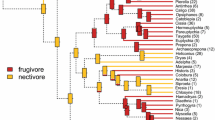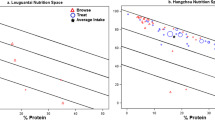Abstract
A nectar diet is simple in nutritional composition and easily digested, but may vary greatly in its proportions of sugar and water. Here, we apply the geometric framework, a modelling approach for investigating how animals balance nutrient needs in multidimensional and dynamic nutritional environments, to captive whitebellied sunbirds (Cinnyris talatala). We address the question of how these small birds (~8 g) prioritise sugar and water intake, and how dietary salt content interacts with sugar and water intake. Sunbirds kept at 20°C and provided with moderate to high sucrose concentrations (≥1 M), together with supplementary water, converge on an intake target of 2.79 g day−1 of sucrose and 7.72 g day−1 of water: equivalent to 0.85 M sucrose. When the birds are given more dilute sucrose concentrations, they defend their sugar intake by over-ingesting water, up to a ceiling of 47 g day−1. Sugar intake thus gets priority over water intake, but the birds have a finite capacity to over-ingest water to gain the target level of sugar. Regulation appears to be less precise when birds are given a choice between two sucrose solutions than when they choose between a sugar solution and supplementary water. Intake targets vary in response to internal and external factors, and sunbirds increase their sugar intake in response to increased activity and cold, irrespective of nectar concentration. They also compensate for interruptions in foraging activity, whether overnight or during the day. Interactive effects become evident when sodium is included as a third nutrient: on very dilute nectar (≤0.1 M), where sunbirds lose body mass, the addition of sodium to the diet helps to achieve the carbohydrate intake target, while raising the ceiling on water intake. This analysis provides a new perspective on nectarivory, while adding to the comparative database on nutrient regulation and emphasising water as a nutrient.





Similar content being viewed by others
References
Adler LS (2000) The ecological significance of toxic nectar. Oikos 91:409–420
Altaye SZ, Pirk CWW, Crewe RM, Nicolson SW (2010) Convergence of carbohydrate-biased intake targets in caged worker honeybees fed different protein sources. J Exp Biol 213:3311–3318
Baker HG, Baker I, Hodges SA (1998) Sugar composition of nectars and fruits consumed by birds and bats in the tropics and subtropics. Biotropica 30:559–586
Barnes K, Nicolson SW, van Wyk B-E (1995) Nectar sugar composition in Erica. Biochem Syst Ecol 23:419–423
Behmer ST, Joern A (2008) Coexisting generalist herbivores occupy unique nutritional feeding niches. Proc Natl Acad Sci USA 105:1977–1982
Dussutour A, Simpson SJ (2008) Carbohydrate regulation in relation to colony growth in ants. J Exp Biol 211:2224–2232
Dussutour A, Latty T, Beekman M, Simpson SJ (2010) Amoeboid organism solves complex nutritional challenges. Proc Natl Acad Sci USA 107:4607–4611
Fisher CD (1972) Drinking patterns and behavior of Australian desert birds in relation to their ecology and abundance. Condor 74:111–136
Fleming PA, Nicolson SW (2003) Osmoregulation in an avian nectarivore, the whitebellied sunbird Nectarinia talatala: response to extremes of diet concentration. J Exp Biol 206:1845–1854
Fleming PA, Gray DA, Nicolson SW (2004a) Circadian rhythm of water balance and aldosterone excretion in the whitebellied sunbird Nectarinia talatala. J Comp Physiol B 174:341–346
Fleming PA, Hartmann Bakken B, Lotz CN, Nicolson SW (2004b) Concentration and temperature effects on sugar intake and preferences in a sunbird and a hummingbird. Funct Ecol 18:223–232
Fleming PA, Xie S, Napier KR, McWhorter TJ, Nicolson SW (2008) Nectar concentration affects sugar preferences in two Australian honeyeaters and a lorikeet. Funct Ecol 22:599–605
Gosby AK, Conigrave AD, Lau NS, Iglesias MA, Hall RM, Jebb SA, Brand-Miller J, Caterson ID, Raubenheimer D, Simpson SJ (2011) Testing protein leverage in lean humans: a randomised controlled experimental study. PLoS One 6:e25929
Jackson S, Nicolson SW, Lotz CN (1998) Sugar preferences and “side bias” in Cape sugarbirds and lesser double-collared sunbirds. Auk 115:156–165
Johnson SD, Nicolson SW (2008) Evolutionary associations between nectar properties and specificity in bird pollination systems. Biol Lett 4:49–52
Köhler A (2009) Food quality, fasting periods and temperature stress: effects of energy challenges on the feeding patterns of avian nectarivores. University of Pretoria, PhD thesis, Pretoria, South Africa
Köhler A, Verburgt L, Nicolson SW (2008) Nectar intake of whitebellied sunbirds (Cinnyris talatala): can meal size be inferred from feeding duration? Physiol Biochem Zool 81:682–687
Köhler A, Leseigneur CDC, Verburgt L, Nicolson SW (2010a) Dilute bird nectars: viscosity constrains food intake by licking in a sunbird. Am J Physiol 299:R1068–R1074
Köhler A, Verburgt L, McWhorter TJ, Nicolson SW (2010b) Energy management on a nectar diet: can sunbirds meet the challenges of low temperature and dilute food? Funct Ecol 24:1241–1251
Köhler A, Verburgt L, Fleming PA, McWhorter TJ, Nicolson SW (2011) Interruptions in nectar availability: responses of White-bellied Sunbirds (Cinnyris talatala) and Brown Honeyeaters (Lichmera indistincta). Emu 111:252–258
Lee KP, Simpson SJ, Raubenheimer D (2004) A comparison of nutrient regulation between solitarious and gregarious phases of the specialist caterpillar, Spodoptera exempta (Walker). J Insect Physiol 50:1171–1180
Lee KP, Behmer ST, Simpson SJ (2006) Nutrient regulation in relation to diet breadth: a comparison of Heliothis sister species and a hybrid. J Exp Biol 209:2076–2084
Lee KP, Simpson SJ, Clissold FJ, Brooks R, Ballard JWO, Taylor PW, Soran N, Raubenheimer D (2008) Lifespan and reproduction in Drosophila: new insights from nutritional geometry. Proc Natl Acad Sci USA 105:2498–2503
Leseigneur CDC, Nicolson SW (2009) Nectar concentration preferences and sugar intake in the white-bellied sunbird, Cinnyris talatala (Nectariniidae). J Comp Physiol B 179:673–679
Leseigneur CDC, Verburgt L, Nicolson SW (2007) Whitebellied sunbirds (Nectarinia talatala, Nectariniidae) do not prefer artificial nectar containing amino acids. J Comp Physiol B 177:679–685
López-Calleja MV, Bozinovic F, Martínez del Rio C (1997) Effects of sugar concentration on hummingbird feeding and energy use. Comp Biochem Physiol A 118:1291–1299
Lotz CN, Nicolson SW (1999) Energy and water balance in the lesser double-collared sunbird (Nectarinia chalybea) feeding on different nectar concentrations. J Comp Physiol B 169:200–206
Lotz CN, Martínez del Rio C, Nicolson SW (2003) Hummingbirds pay a high cost for a warm drink. J Comp Physiol B 173:455–462
Markman S, Pinshow B, Wright J, Kotler BP (2004) Food patch use by parent birds: to gather food for themselves or for their chicks? J Anim Ecol 73:747–755
Martínez del Rio C, Schondube JE, McWhorter TJ, Herrera LG (2001) Intake responses in nectar feeding birds: digestive and metabolic causes, osmoregulatory consequences, and coevolutionary effects. Am Zool 41:902–915
Mayntz D, Raubenheimer D, Salomon M, Toft S, Simpson SJ (2005) Nutrient-specific foraging in invertebrate predators. Science 307:111–113
Napier KR, Purchase C, McWhorter TJ, Nicolson SW, Fleming PA (2008) The sweet life: diet sugar concentration influences paracellular glucose absorption. Biol Lett 4:530–533
Nicolson SW, Fleming PA (2003a) Nectar as food for birds: the physiological consequences of drinking dilute sugar solutions. Plant Syst Evol 238:139–153
Nicolson SW, Fleming PA (2003b) Energy balance in the Whitebellied Sunbird Nectarinia talatala: constraints on compensatory feeding, and consumption of supplementary water. Funct Ecol 17:3–9
Nicolson SW, Thornburg RW (2007) Nectar chemistry. In: Nicolson SW, Nepi M, Pacini E (eds) Nectaries and nectar. Springer, Dordrecht, pp 215–264
Nicolson SW, Hoffmann D, Fleming PA (2005) Short-term energy regulation in nectar-feeding birds: the response of Whitebellied Sunbirds (Nectarinia talatala) to a midday fast. Funct Ecol 19:988–994
Purchase C, Nicolson SW, Fleming PA (2010) Added salt helps sunbirds and honeyeaters maintain energy balance on extremely dilute nectar diets. J Comp Physiol B 180:1227–1234
Raubenheimer D (2011) Towards a quantitative nutritional ecology: the right-angled mixture triangle. Ecol Monogr 81:407–427
Raubenheimer D, Gäde G (1994) Hunger-thirst interactions in the Locust, Locusta migratoria. J Insect Physiol 40:631–639
Raubenheimer D, Simpson SJ (1993) The geometry of compensatory feeding in the locust. Anim Behav 45:953–964
Raubenheimer D, Simpson SJ (1997) Integrative models of nutrient balancing: application to insects and vertebrates. Nutr Res Rev 10:151–179
Raubenheimer D, Simpson SJ (1998) Nutrient transfer functions: the site of integration between feeding behaviour and nutritional physiology. Chemoecology 8:61–68
Raubenheimer D, Simpson SJ (1999) Integrating nutrition: a geometrical approach. Entomol Exp Appl 91:67–82
Raubenheimer D, Simpson SJ (2003) Nutrient balancing in grasshoppers: behavioural and physiological correlates of dietary breadth. J Exp Biol 206:1669–1681
Raubenheimer D, Simpson SJ (2006) The challenge of supplementary feeding: can geometric analysis help save the kakapo? Notornis 53:100–111
Raubenheimer D, Zemke-White WL, Phillips RJ, Clements KD (2005) Algal macronutrients and food selection by the omnivorous marine fish Girella tricuspidata. Ecology 86:2601–2610
Rothman JM, Van Soest PJ, Pell AN (2006) Decaying wood is a sodium source for mountain gorillas. Biol Lett 2:321–324
Rothman JM, Raubenheimer D, Chapman CA (2011) Nutritional geometry: gorillas prioritize non-protein energy while consuming surplus protein. Biol Lett 7:847–849
Schaefer HM, Schmidt V, Bairlein F (2003) Discrimination abilities for nutrients: which difference matters for choosy birds and why? Anim Behav 65:531–541
Scheepers A, Joost HG, Schurmann A (2004) The glucose transporter families SGLT and GLUT: molecular basis of normal and aberrant function. J Parenter Enter 28:365–372
Shariatmadari F, Forbes JM (1993) Growth and food intake responses to diets of different protein contents and a choice between diets containing two concentrations of protein in broiler and layer strains of chicken. Br Poult Sci 34:959–970
Simpson SJ, Raubenheimer D (1993) A multi-level analysis of feeding behaviour: the geometry of nutritional decisions. Philos T Roy Soc B 342:381–402
Simpson SJ, Raubenheimer D (1995) The geometric analysis of feeding and nutrition: a user’s guide. J Insect Physiol 41:545–553
Simpson SJ, Raubenheimer D (1997) Geometric analysis of macronutrient selection in the rat. Appetite 28:201–213
Simpson SJ, Raubenheimer D (2005) Obesity: the protein leverage hypothesis. Obes Rev 6:133–142
Simpson SJ, Raubenheimer D (2012) The nature of nutrition: a unifying framework from animal adaptation to human obesity. Princeton University Press, Princeton
Simpson SJ, Raubenheimer D, Behmer ST, Whitworth A, Wright GA (2002) A comparison of nutritional regulation in solitarious- and gregarious-phase nymphs of the desert locust, Schistocerca gregaria. J Exp Biol 205:121–129
Simpson SJ, Sibly RM, Lee KP, Behmer ST, Raubenheimer D (2004) Optimal foraging when regulating intake of multiple nutrients. Anim Behav 68:1299–1311
Tooze ZJ, Gass CL (1985) Responses of rufous hummingbirds to midday fasts. Can J Zool 63:2249–2253
Welch KC, Suarez RK (2007) Oxidation rate and turnover of ingested sugar in hovering Anna’s (Calypte anna) and rufous (Selasphorus rufus) hummingbirds. J Exp Biol 210:2154–2162
Acknowledgments
This work was supported by the University of Pretoria, the South African National Research Foundation and the Claude Leon Foundation. DR received support from the Massey University Research Fund.
Author information
Authors and Affiliations
Corresponding author
Additional information
Communicated by I.D. Hume.
Rights and permissions
About this article
Cite this article
Köhler, A., Raubenheimer, D. & Nicolson, S.W. Regulation of nutrient intake in nectar-feeding birds: insights from the geometric framework. J Comp Physiol B 182, 603–611 (2012). https://doi.org/10.1007/s00360-011-0639-2
Received:
Revised:
Accepted:
Published:
Issue Date:
DOI: https://doi.org/10.1007/s00360-011-0639-2




